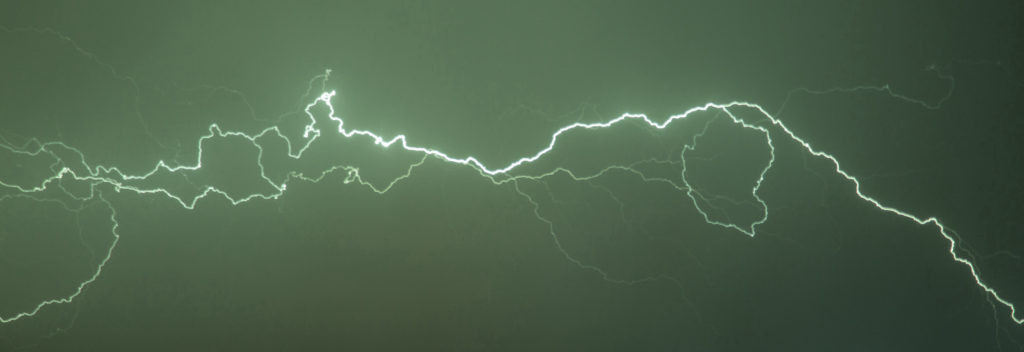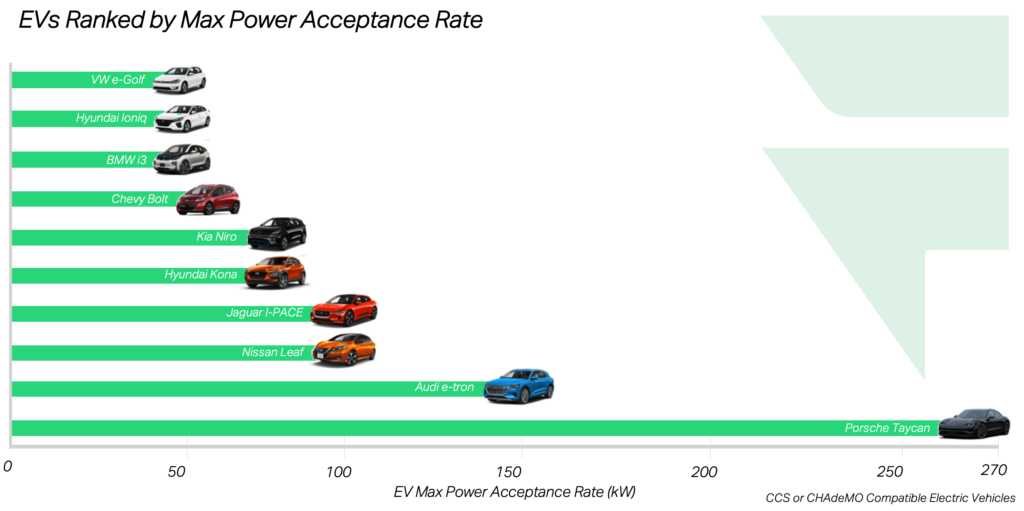Choosing the Right Power for Your Public EV Charger
Are you deciding between a 50 kW, 100 kW, or 350 kW fast electric vehicle (EV) charger? Let’s help you make a market-informed decision for your site.
EV adoption is growing rapidly. Over two hundred new models of battery EVs (BEV) and plug-in hybrid EVs (PHEV) will be introduced in the next two years alone. According to McKinsey & Company, between 5-9 million EVs will be on the road in the US by 20301 2.New business and service models are opening to address the need for widespread charging. As EVs evolve to accept more power at higher rates, direct current fast chargers (DCFCs) are necessary for public and fleet charging.
There are many factors to consider when installing a new DCFC. Charger power output, or charger speed3, is a critical factor when determining which charger is best suited for both drivers and your bottom-line. We’ll look at the EV market and cost factors to help inform charger power selection.
How Fast do EVs Charge?
Deciding on the right EV charger to install can be informed by the maximum power drivers’ EVs can accept. All EVs have a maximum power acceptance rate dictated by the vehicle’s battery and charging technology, which can be very different between EV models. For example, a Chevrolet Bolt has a maximum charge rate of 55 kW, whereas a Porsche Taycan charges at the highest rate among today’s EV models at 270 kW. Current Tesla models charge up to 250 kW. The graphic below demonstrates the varying charge rates for several leading EV models.
Commuter EVs have experienced a much higher adoption rate than premium EV models; therefore, the distribution of EVs on the road is weighted towards EVs with lower maximum power acceptance. We’ll explore this more below.
Access to Charging Connectors
There are four main connector types: Tesla, CCS, CHAdeMO, and J1772. Tesla manufactures its proprietary charger and connector specific to Tesla EVs. Public Tesla charging stations are not readily available for purchase, barring site hosts from owning and operating this type of charger and connector. Therefore, site hosts have an opportunity to provide public charging to the EV market using non-Tesla connectors.
Commercial chargers using J1772, CCS, and CHAdeMO connectors are available through most major electric vehicle service equipment manufacturers. These connectors are compatible with major EV manufacturers, including Nissan, Chevrolet, BMW, and more. The main users of your chargers will be EV drivers with these connectors and, in some cases, Tesla drivers with an adapter. Let’s look at the maximum charge rate distribution for these EV models to inform your charger’s ideal charging power.
Distribution of Charging Speed by EV Model
There is a wide range of maximum power acceptance rates for non-Tesla EVs, from 7 to 270 kW. However, the distribution of EV models by acceptance rate is not even. Using BEV sales data from 2011-20194, the majority of EVs (79%) had a max charge rate between 50-99kW. This is followed by EV’s charging at a rate of 1-49kW, and only a small percentage (4%) capable of charging over 100 kW. The Sankey diagram below breaks down total EV sales by connector type, model, and maximum acceptance rate.

How Fast Does my Charger Need to Be?
With DCFC charging speeds ranging from 50-350 kW, how do you choose what’s right for your business? This decision depends on how you answer several questions. Is your customer base more likely to drive the most broadly selling passenger EVs, or will they be driving luxury vehicles or even medium- or heavy-duty trucks? Does your site have limited electrical capacity? Are your utility electric rates high, especially at peak times or with demand charges?
A high-power 350 kW charger can supply enough charging capacity to power all EVs now and for the foreseeable future. It also distinguishes the site host by likely hosting the fastest charging option in a given area, even if most EV drivers cannot fully experience this. Most fast chargers over 50 kW require high power input, typically 480 V, necessitating electrical infrastructure upgrades. Additionally, the charger host risks high ongoing operational energy costs through increased energy bills compounded by demand charges. While most EVs charged will be below the charger max power, just one charging session using the highest power can incur significant fees.
Hosting a charger in the 100-200 kW range is suitable for most publicly owned EVs. For all fast chargers, consider a mix between CCS and CHAdeMO connectors to serve all non-tesla models. To mitigate ongoing energy costs and demand charges, consider pairing your station or purchasing a charger with integrated energy storage. This can effectively buffer the power demand for EVs with a high maximum acceptance rate while requiring lower upfront installation costs through minimal electrical infrastructure updates.
While new EV models are being introduced rapidly over the coming years, a 100-200 kW DC fast charger will meet the needs of most EV drivers while minimizing the impact on the site host.
It’s an exciting time for transportation electrification and the opportunity to serve this market. For more news, analysis, and insight, be sure to subscribe to our newsletter or contact our energy specialists to find the right for your site.
1 McKinsey & Company, How charging in buildings can power up the electric-vehicle industry, 2015, https://www.mckinsey.com/industries/electric-power-and-natural-gas/our-insights/how-charging-in-buildings-can-power-up-the-electric-vehicle-industry?cid=eml-web
2 The data provided in this article primarily address public EV charger stations in the United States; however, the same concepts are applicable across markets experiencing EV growth.
3 For more information on types of chargers and charging speeds, see our blog What’s the Difference Between EV Charging Levels?
4 Transportation Research Center at Argonne National Laboratory, anl.gov/es/light-duty-electric-drive-vehicles-monthly-sales-updates

